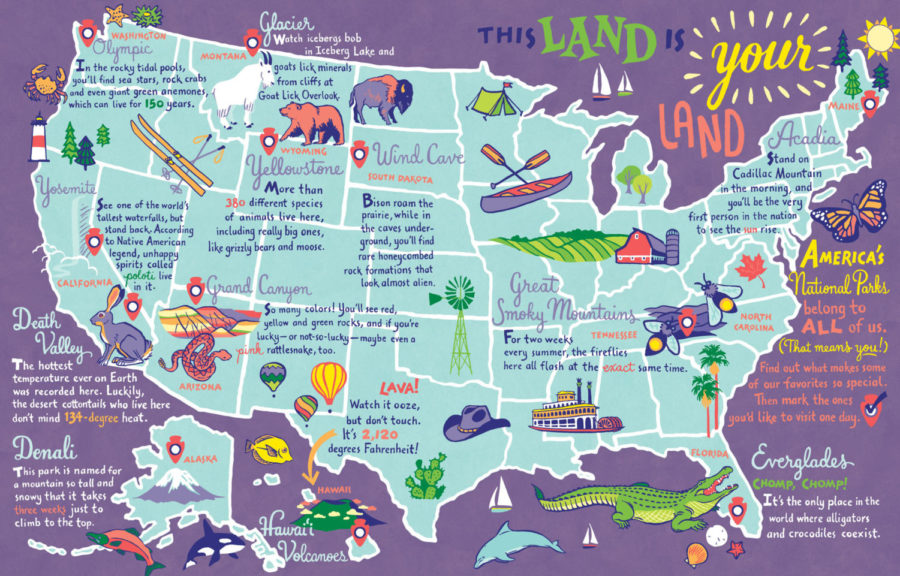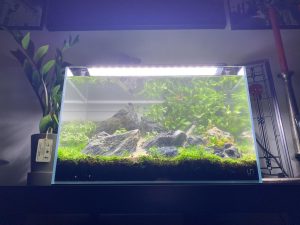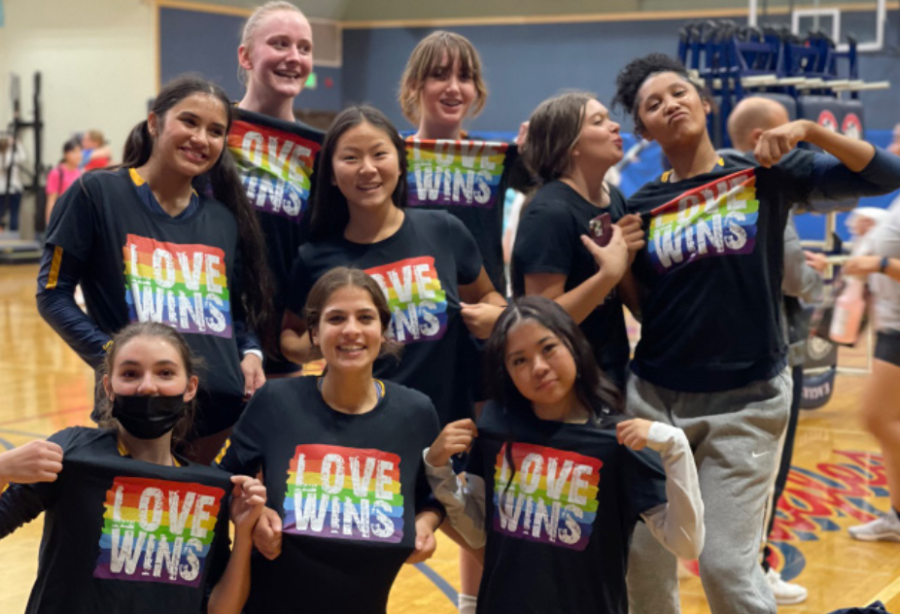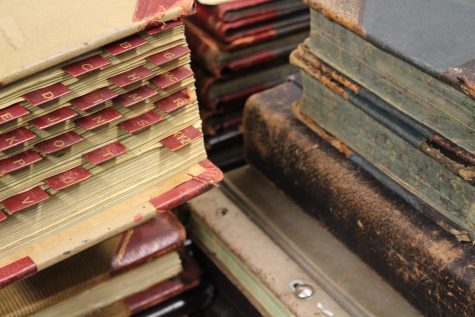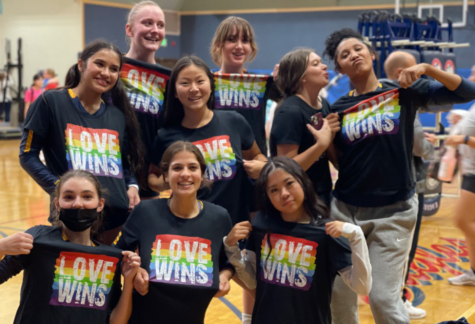Local artist offers inspiration
December 26, 2017183 Views
Chandler O’Leary, wife of Upper School science teacher Donald Sidman, is a well known artist based in Tacoma. Her artwork is displayed in shows across the globe.
In 2016, O’Leary published the book Dead Feminists, which illustrates past feminists and discusses their accomplishments. It’s both inspiration and a guide for anyone looking to make a difference. Her Dead Feminists Fund contributes to charities aiming to empower females such as the Women’s Sports Foundation. Portions of the fund come from the book sales as well as direct donations.
One of her current projects, Drawn the Road Again, includes artwork depicting the places she has traveled, including her 50 States Series. She is planning to publish an illustrated atlas in 2019.
Inkwell interviewed O’Leary about her work, inspiration and advice for aspiring artists.
Inkwell: Who or what was the inspiration behind your in-house brand Anagram Press?
O’Leary: That name comes from the history of letterpress printing (though I consider myself an illustrator and letterer, I started out as a letterpress printer as a way to get my images out into the world). Printers who work with wood and metal type (and in the early days of printing, all printers worked this way) set their text by moving individual letters around, block by block. That process reminded me of anagrams, which are word puzzles solved by moving letters around to make new words.
Inkwell: What advice do you have for someone still in high school who wants to be an artist?
O’Leary: I think the two biggest skills you can develop are drawing and discipline. Even if you don’t end up working as an artist who draws (a painter, an illustrator, etc.), drawing teaches you to be observant—to notice the world around you, and to put what you see down on paper in some way. If you can learn to be observant, you’ll never lack for ideas. Drawing also helps you understand what you see, as it forces you to really look and study whatever you’re drawing — like exercising a muscle, developing a drawing practice makes you stronger as a designer, observer and storyteller.
Discipline is a tougher “muscle” to develop. People talk about artists finding “inspiration” and “creativity,” but the reality of working as an artist is that sometimes you have to come up with ideas and make art when you don’t feel like it, or when you’re tired or sad or sick. This is where discipline and habits really come in handy. If you can get in the habit of showing up every day, rain or shine, distractions or no distractions, and making something — it might be a drawing, or a photograph, or a rough idea, even — you’ll develop the discipline you’ll need to be a professional artist. You’ll also make an incredible amount of work this way! Just by showing up every day and making something, good or bad, you’ll quickly accumulate an ever-growing portfolio of art. The more work you create, the more people will be able to find you and follow along with you.
Inkwell: What has been the biggest challenge you’ve faced as an artist and how did you overcome it?
O’Leary: Self-doubt, I think. It’s something I’m still working on — I’ll probably always be working on it. It’s so easy to second-guess one’s own ideas, to reject an idea before you even get started. That kind of self-doubt (“What if this isn’t good? What if nobody likes it? What if I mess up? What if I don’t know where this is going? What if so-and-so does it better?”) leads to procrastination and a fear of the blank page, and I think it’s something all artists struggle with. One way I work around it is to keep sketchbooks — that way I’m always drawing, and I can flesh out ideas without anyone having to see it (unless I want to share it). Another thing I try to do is break projects into smaller chunks, sometimes really tiny tasks, if need be. This makes a project seem less daunting, and helps me push through that fear and procrastination. If all I’m doing this morning, for example, is drawing one pineapple, that’s easy. Maybe tomorrow I’ll draw another pineapple, but then I sit down to do that, and on a whim I draw a flower next to it, and before I know it, I’ve drawn 50 pineapples and 100 flowers and 35 exotic birds, and an idea just hit me to do a big painting about Hawaiian species, and here I am all excited to build on my sketches, and I’ve forgotten all about the doubts I felt at the beginning. It doesn’t always work out this way, but these little “tricks” I devise for myself certainly help.
Inkwell: In such a competitive field, how do you manage to stand out and find such a unique voice for your art?
O’Leary: This relates to my previous answer—I really try hard not to think about “the competition,” or to compare myself to others. It’s easy to fall into that trap, but the danger is that you might scare yourself into giving up, or else copying others (which is harmful both to them and to you — don’t copy other artists’ work!). Instead, I try to just trust my own interests, process and ideas, and put my work out into the world. I also try not to force a particular style or voice into appearing; time and practice take care of most of that, and before you know it, your “unique voice” has appeared of its own accord. My travel sketchbooks are a good example of this. I have kept sketchbooks of my travels for about 20 years now. At first it was just something I did for me, for fun. I didn’t put my sketches on my website very often, and I didn’t really show a lot of people what I was doing. I didn’t try to draw in any particular way or style; I just did what came naturally to me, and used materials I liked and knew how to use. Eventually I became comfortable with my process, and my sketchbooks took on a pretty unified look. A friend convinced me to start a travel blog, so I founded Drawn the Road Again in 2013. By then I had hundreds of sketches already under my belt, and because I had just quietly done my own thing for so many years, my drawings were both unique in style and very cohesive as a body of work. So now when my travel sketches pop up online, you can usually tell it’s me. That visual “voice” wasn’t something I consciously cultivated, but something that arose naturally over time. So to others I’d say don’t worry so much about trying to find your artistic voice; just keep trying things out, and give yourself plenty of time, and your voice will find you.
Just keep trying things out, and give yourself plenty of time, and your voice will find you. — Chandler O'Leary
Inkwell: What’s the best way to find other artists to collaborate with?
O’Leary: Collaboration is a tricky beast. It can be very rewarding, but just like any relationship, it can be hard to find the right collaborator. I’m very lucky to have found Jessica Spring, my collaborator on the Dead Feminists project. She and I have found that “secret sauce” that works for us, but it doesn’t always work out that way. I have had some collaborations go horribly wrong, while others simply peter out or just aren’t very satisfying. But I think the important thing is to make friends with artists. Get to know lots of different artists in lots of different disciplines. Sometimes you get an idea to collaborate simply because you met an inspiring person who does work that’s completely different from what you do. And even if you don’t end up collaborating with them, your artist friends will be understanding and supportive in a unique way, since they know what you’re going through and where you’re coming from.
If you do find someone to collaborate with, go slowly and give it some time to see if it’s working out. Start by doing one small project together, and see where that goes. If it doesn’t go anywhere, that’s okay. You can continue to do your own work, and you can try collaborating with someone else. Jessica and I never meant to do a whole series that has lasted nearly a decade and counting — all we set out to do was create one piece together. That worked out well, so we did another. We got to know each other better as time went on, and together, we figured out what worked for us, and what didn’t. We don’t always agree, but we do always communicate with each other, and we always keep each other in mind as we explore new ideas and opportunities. I think that communication has been the most important thing for us. Neither of us makes a Dead Feminists decision without consulting the other first. If someone contacts one of us about our series, we make sure we’re both looped into the conversation. If one of us has an idea, or wants to change something, we have a discussion about it. We keep checking in with each other to make sure we’re still on the same page as we go forward, and that has served us well. We’re also absolutely vigilant to make sure we each get equal credit for our project (a lot of times, like in articles or reviews or even gallery shows, only one of us will be listed as the artist—we’re very quick to jump in and correct things, and make sure we both get credit for the work), and that we split the income from our collaboration evenly and fairly. Even when we wrote our Dead Feminists book, we both contributed equally to the writing and imagery (illustrations and lettering on my end; historical ephemera and original letterpress prints on her end). I think that’s the biggest reason why we’ve been able to collaborate for so long: it’s not a case of one person leading and the other following, it’s really an equal partnership. And each of us continues to do her own solo work, as well—so when we come together to collaborate on the next thing, it’s always something fresh and new for us.
Inkwell: What’s your favorite experience that your career has brought you to do?
O’Leary: This is a tough question, because I’ve had so many rewarding experiences and opportunities, and I’ve been really fortunate in that respect. I think my favorite part, though, has been the traveling I’ve been able to do because of my work. I love traveling more than almost anything in life, and I love that doing my work has allowed me to do more and more traveling. Last year I was awarded a grant to spend two weeks exploring and drawing in the Palouse region of southeastern Washington, and it was an incredibly memorable experience. I was so lucky to have the time and financial freedom that the grant allowed me. And several times I’ve had the opportunity to gain access to places not open to the public, simply because someone knew that I’d like the chance to draw there (or even just see it!), and they had the power to give me that opportunity. There have been fairly mundane versions of this, like someone inviting me into their private home where they have a beautiful or unusual view—as well as incredibly rare moments, like the time I was allowed to spend a half hour in the Sistine Chapel all by myself, absolutely alone with the artwork. These experiences are incredible gifts for me, and I know that they would never have happened without the kindness and generosity of others, so I’m as grateful for these people as I am for the experiences themselves.
Inkwell: In your book Dead Feminists, you have a timeline of historical feminists. What time period of feminists would you say you relate to the most?
O’Leary: I am particularly interested in the 1920s, because it was a period in history that greatly resembles the present day. That decade saw both the peak and the end of what’s called the Progressive Era. It was a period of great prosperity for many, thanks to new technological innovations like cars, many labor-saving devices for the home, and the brand-new notion of everyday people buying these “luxuries” on credit, allowing them to rise to the middle class. There were new protections in place for workers, like the new 40-hour work week and refinements on the previous decades’ labor laws and unions. It was an era of sweeping social change, particularly for women, who were beginning to enter the workforce and even own businesses in greater numbers than ever before. Women had just gained the vote in the U.S. and were embracing more liberal forms of dress and expression. The arts flourished in the 1920s, from the advent of jazz music to exciting new movements in design, sculpture and architecture. It was also a period of great excess and inequality: by the end of the decade, laws tended to favor corporations and financial speculators, while ordinary people went deep into debt to sustain their new prosperous lifestyles. Old prejudices flared up again, too: the KKK, which had faded into obscurity thanks to legislation in the 1870s, rose to new prominence, and had more than 4 million members across America in the 1920s. These things, as well as unsustainable environmental practices (farming techniques, etc.), led to the Stock Market Crash of 1929, the Great Depression and Dust Bowl drought that followed, and the rise of fascism in Europe and elsewhere. Many historians and analysts are seeing similar patterns playing out today, from the financial excesses, to the environment, to technological advances, to political extremism. So I think it’s even more important to study the past, in hopes of avoiding the same mistakes we made then.
Inkwell: Is there anything you can tell me about your upcoming illustrated atlas?
O’Leary: My next book (it’s just me this time; I’m both author and illustrator) will be an illustrated atlas of the West Coast. Like my Drawn the Road Again blog, there won’t be a single photograph in the entire book. It will contain all new illustrations, hand-drawn maps and original text to tell the story of the West Coast from the perspective of a road trip. The book focuses on the historic West Coast highways (Highway 99, Highway 101 and California’s Highway 1), and travels along these routes from the Mexican border to the Canadian border, highlighting natural wonders, roadside attractions and iconic landmarks along the way. The book will be published by Sasquatch Books in spring 2019.
Inkwell: What to you is the biggest injustice people are facing today?
O’Leary: Inequality and prejudice—those two things go hand in hand, and they are everywhere. This past year of ugly politics has shown that we have not moved past this injustice. Women still have unequal pay and unequal power at work, in the courts, in politics, everywhere. People of color are still feared and mistrusted, and they suffer an enormous burden of abuse and inequality wherever they go. The rich get more wealthy every day, as they strip protections and freedoms from the poor. The United States Supreme Court is currently debating whether businesses can legally deny service to gay people, the way they denied service to Black people 60 years ago. That same court upheld our new President’s ban on people from certain countries entering the U.S., simply because they are Muslim. A hundred years ago we decided the Chinese shouldn’t enter the U.S., and before that we vilified the Irish and the Italians. Throughout our collective history, humans have arbitrarily decided that some of us are better than others, and have used some combination of fear, force and unfair laws to keep that inequality in place. We must all fight inequality wherever we find it, and speak up when we encounter prejudice, both against ourselves and against others. Stopping the cycle of injustice begins with us.
Inkwell: What’s one piece of advice that you wish you could tell every girl?
O’Leary: Find the courage, if you can, to be yourself—and to trust your own instincts. All women and girls face an enormous amount of pressure to conform to somebody else’s ideals and wishes. We are told to smile and be “nice,” to look and dress a certain way, to weigh a certain amount, to hold certain opinions, to sacrifice our wants and needs for someone else’s. Yet the more we listen to our own inner voice, the more confident in ourselves we become, and the easier it becomes to resist that external pressure. What makes you you is your biggest strength, your biggest asset — learn to celebrate and trust who you are. And trust your fellow women and girls. You are your own best advocate, and women are the best advocates for women. Support each other as you support yourself.
What makes you you is your biggest strength, your biggest asset — learn to celebrate and trust who you are.
— Chandler O'Leary
Visit O’Leary’s web site http://chandleroleary.com to visit her online shop and see her blog, which contains personal statements on her pieces and perspectives on current and historical events.


